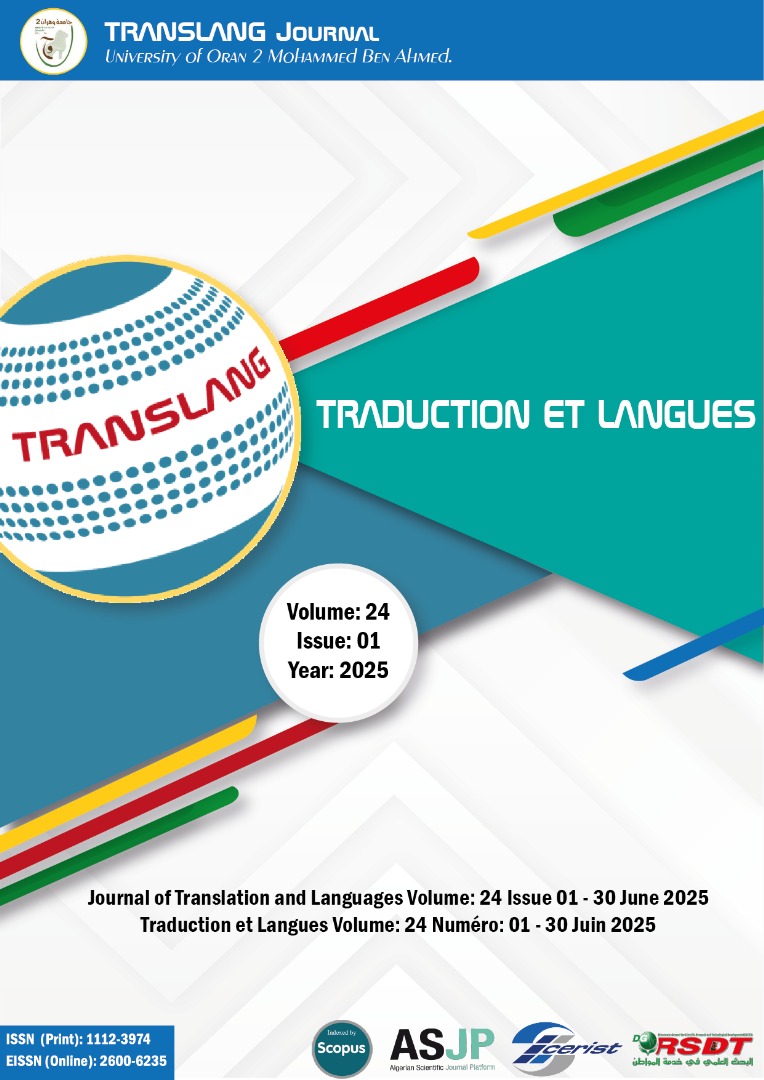Gender Dynamics in Qur'anic Translation: Analyzing Male and Female Perspectives on Surat Al-Fatiha
Main Article Content
Abstract
This paper investigates the impact of gender perspectives on the translation of Surat Al-Fatiha, a pivotal chapter in the Qur'an, through a comparative analysis of translations produced by both male and female scholars. By closely examining the works of Yusuf Ali, Muhammad Marmaduke Pickthall, Laleh Bakhtiar, and Amina Wadud, this study explores the ways in which gendered approaches shape the interpretation, rendering, and presentation of sacred Islamic texts. The selection of these translators provides a balanced representation of traditional and contemporary viewpoints, allowing for a nuanced exploration of how gender identity and scholarly perspective inform translation choices. Yusuf Ali’s and Pickthall’s translations are analyzed for their traditional and formal approaches, with particular attention paid to the influence of their respective historical, cultural, and religious contexts. Ali’s work is characterized by extensive commentary and an emphasis on bridging cultural divides through interpretive footnotes and annotations, while Pickthall’s translation remains closely aligned with classical interpretations, highlighting his commitment to linguistic and theological fidelity rooted in early Islamic tradition. In contrast, Bakhtiar’s feminist approach offers a critical engagement with gender biases embedded in traditional exegesis, seeking to reinterpret specific terms and concepts in ways that challenge patriarchal readings. Wadud’s academic perspective brings an intellectually rigorous yet spiritually engaged approach that integrates contemporary scholarship with a critical engagement of traditional Islamic interpretations. Her work reflects a synthesis of modern hermeneutical tools and classical exegetical insights, aiming to uncover the egalitarian spirit of the Qur’an while remaining rooted in its historical context.The analysis reveals how gender perspectives affect the translation of key phrases and concepts, influencing the text’s reception among diverse audiences. These findings underscore the important role that gendered translation practices play in either reinforcing or challenging established interpretations of sacred scripture. This research advances the theoretical understanding of gender in translation by demonstrating the practical effects of gendered perspectives on sacred texts. It demonstrates the tangible effects of gendered perspectives on sacred texts and offers thoughtful recommendations for future translators, emphasizing the importance of inclusivity and interpretive sensitivity to foster meaningful cross-cultural and interfaith dialogue.
Metrics
Article Details
References
Ali, Y. (1938). The meaning of the Holy Qur'an. Islamic Publications.
Ariesita, D. K., & Adhitya, G. N. (2023). Seeing Muslim men and women hermeneutically: A liberal-feminist study on Amina Wadud’s Qur’an exegesis. Rubikon: Journal of Transnational American Studies, 10(1), 91. https://doi.org/10.22146/rubikon.v10i1.78363
Baker, M. (2006). Translation and conflict: A narrative account. Routledge.
Bakhtiar, L. (2007). The sublime Qur'an. Kazi Publications.
Federici, E., & Santaemilia, J. (2021). Gender and translation: New perspectives (Routledge Advances in Translation and Interpreting Studies). Routledge.
Ibn Kathir, I. (2003). Tafsir Ibn Kathir. Dar al-Kutub al-Ilmiyyah.
Memon, M. (1988). British Muslim converts: Pickthall and other converts. Islamic Studies, 27(2), 142–160.
Mir-Hosseini, Z. (2000). Islam and gender: The religious debate in contemporary Iran. I. B. Tauris.
Moghissi, H. (1999). Feminism and Islamic fundamentalism: The limits of postmodern analysis. Zed Books.
Nasr, S. H., Dagli, C. K., Dakake, M. M., Lumbard, J. E., & Rustom, M. (2015). The study Quran: A new translation and commentary. HarperCollins.
Nida, E. A. (1964). Toward a science of translating. Brill.
Pickthall, M. M. (1930). The meaning of the glorious Qur'an. Islamic Propagation Center.
Pym, A. (2015). Translation solutions for many languages: Histories and philosophies. Routledge.
Resky, M., & Hasibuan, A. R. (2024). Issues on gender equality in the Qur'an based on Amina Wadud's hermeneutical approach. Besari: Journal of Social and Cultural Studies, 2(1), 33–46. https://doi.org/10.71155/besari.v2i1.108
Saeed, A. (2013). Reading the Qur'an in the twenty-first century: A contextualist approach. Routledge.
Spivak, G. C. (1988). Can the subaltern speak? In C. Nelson & L. Grossberg (Eds.), Marxism and the interpretation of culture (pp. 271–313). University of Illinois Press.
Venuti, L. (1995). The translator's invisibility: A history of translation. Routledge.
Wadud, A. (2006). The Qur'an and woman: Rereading the sacred text from a woman’s perspective. Oxford University Press.
Zhu, L., Ang, L. H., & Mansor, N. S. (2023). Interaction between gender and translation (1995–2022): A systematic literature review. World Journal of English Language, 13(6), 420.
